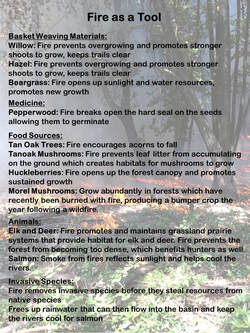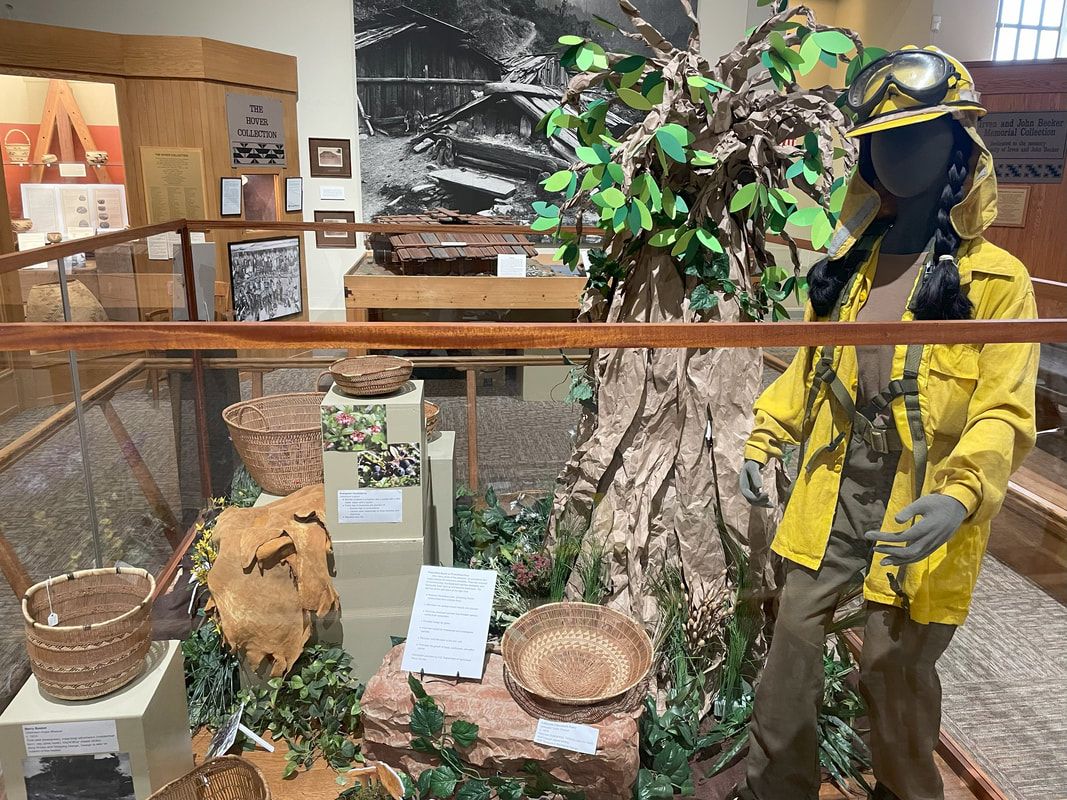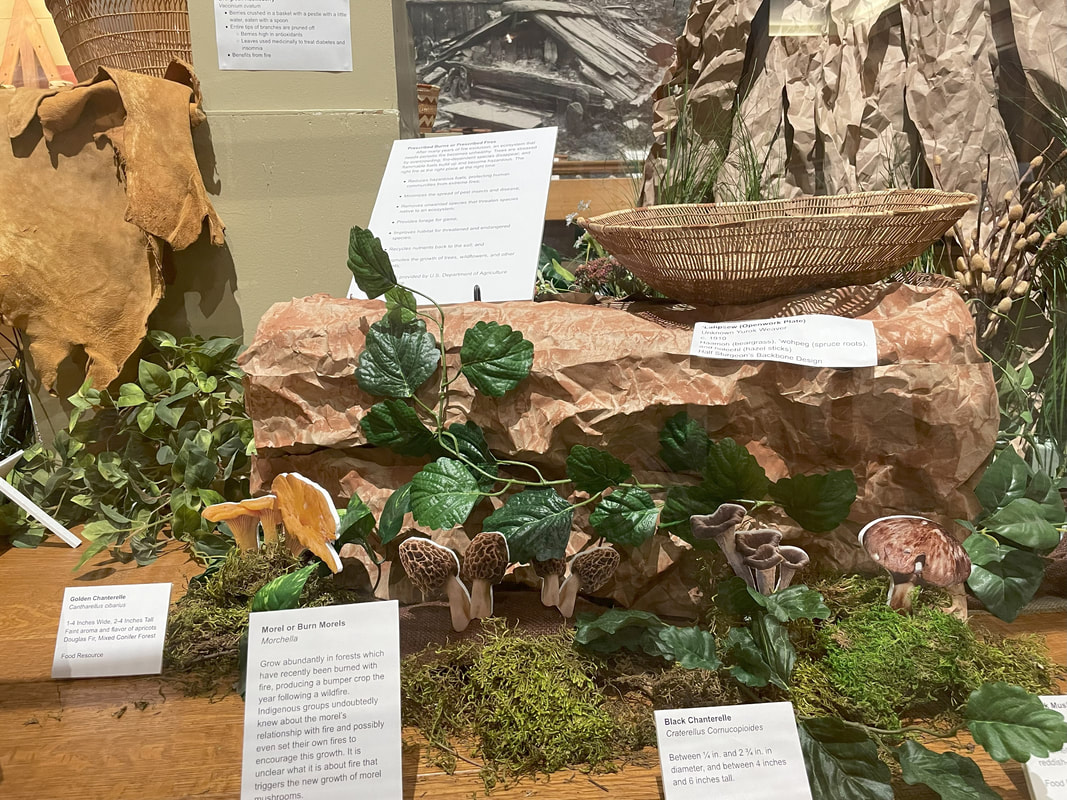Ecological Management
Ecological Management
This exhibit highlights Indigenous resources and foods beyond salmon and acorns, exploring traditional ecological management practices in our local landscape and examining the long history of Indigenous land management, including fire as a tool. Traditional ecological knowledge is an ancestral practice, but it is also medicine that would have been used in any relatively isolated rural community in the 1920’s-1930’s, where doctors trained in modern medicine were miles away.
This exhibit highlights Indigenous resources and foods beyond salmon and acorns, exploring traditional ecological management practices in our local landscape and examining the long history of Indigenous land management, including fire as a tool. Traditional ecological knowledge is an ancestral practice, but it is also medicine that would have been used in any relatively isolated rural community in the 1920’s-1930’s, where doctors trained in modern medicine were miles away.
Traditional Ecological Knowledge (TEK)
Traditional ecological knowledge cannot be separated from either the practices that generated the information or the practices that emerge from it. Land management practices, regulating fisheries through ceremony and forest through fire. Indigenous practices of tending, burning and harvesting have fundamentally shaped species abundance and diversity. Traditional management practices are an essential expression of Indigenous culture.
What natural scientists have described as “nature” or “natural history” is in fact human-natural history. When European settlers arrived on the California landscape, they assumed that the ecology was an “untouched wilderness”, when it is actually a carefully tended garden. Fire records of California clearly indicate Indigenous land management, which shaped the evolutionary course of plant species and communities for at least 12,000 years. Traditional fire management has influenced the size, extent, pattern, structure and composition of flora and fauna of numerous vegetation types throughout the state.
Information provided by Karuk Traditional Ecological Knowledge and the Need for Knowledge Sovereignty: Social, Cultural and Economic Impacts of Denied Access to Traditional Management by Dr. Kari Marie Norgaard
Traditional ecological knowledge cannot be separated from either the practices that generated the information or the practices that emerge from it. Land management practices, regulating fisheries through ceremony and forest through fire. Indigenous practices of tending, burning and harvesting have fundamentally shaped species abundance and diversity. Traditional management practices are an essential expression of Indigenous culture.
What natural scientists have described as “nature” or “natural history” is in fact human-natural history. When European settlers arrived on the California landscape, they assumed that the ecology was an “untouched wilderness”, when it is actually a carefully tended garden. Fire records of California clearly indicate Indigenous land management, which shaped the evolutionary course of plant species and communities for at least 12,000 years. Traditional fire management has influenced the size, extent, pattern, structure and composition of flora and fauna of numerous vegetation types throughout the state.
Information provided by Karuk Traditional Ecological Knowledge and the Need for Knowledge Sovereignty: Social, Cultural and Economic Impacts of Denied Access to Traditional Management by Dr. Kari Marie Norgaard
Gathering Ethics:
- Only gather what you will use
- Take good care of what you gather
- Share with people who need it and can't gather themselves
- If you are able, gather from more difficult to reach areas, leaving easily accessible areas for elders
- Cut branches of flowers or leaves from multiple different plants, do not pull up the whole plant, this will kill it
- Take less than 5% of a shrub
Gather plants from large populations
Only gather common plants
Avoid gathering frequently from the same place
Bring wild plants into your garden
Learn about invasive exotic species
Gather only from healthy plants
Information provided by After the First Full Moon in April by Josephine Peters (Karuk Elder) and Beverly Ortiz
- Take a small amount from several plants to reduce your impact on the overall population
- Get to know the plants and adjust your gathering methods to ensure that the plants thrive
Only gather common plants
- Be certain of plant identification before harvesting
Avoid gathering frequently from the same place
- Slow growing plants can easily be overharvested
- Encourage others to do the same
Bring wild plants into your garden
- Gather seeds or cuttings to grow in your garden so you do not have to keep finding new places
Learn about invasive exotic species
- Remove invasive species from your gathering sites
- Be aware that you are spreading seeds as you move from one place to another, if you have seeds of invasive weeds in/on your shoes remove them as best you can before going to another site
Gather only from healthy plants
- Do not gather from areas infected with sudden oak death or port orford cedar root disease.
- Learn to recognize the symptoms of these diseases and take care not to spread them. Port orford cedar root disease can be spread on shoes and car tires, sudden oak death can infect many species of native plants and can be spread by moving infected plants, including firewood
Information provided by After the First Full Moon in April by Josephine Peters (Karuk Elder) and Beverly Ortiz

Prescribed Burns or Prescribed Fires
After many years of fire exclusion, an ecosystem that needs periodic fire becomes unhealthy. Trees are stressed by overcrowding; fire-dependent species disappear; and flammable fuels build up and become hazardous. The right fire at the right place at the right time:
Information provided by U.S. Department of Agriculture Forest Service
After many years of fire exclusion, an ecosystem that needs periodic fire becomes unhealthy. Trees are stressed by overcrowding; fire-dependent species disappear; and flammable fuels build up and become hazardous. The right fire at the right place at the right time:
- Reduces hazardous fuels, protecting human communities from extreme fires;
- Minimizes the spread of pest insects and disease;
- Removes unwanted species that threaten species native to an ecosystem;
- Provides forage for game;
- Improves habitat for threatened and endangered species;
- Recycles nutrients back to the soil; and
- Promotes the growth of trees, wildflowers, and other plants;
Information provided by U.S. Department of Agriculture Forest Service


